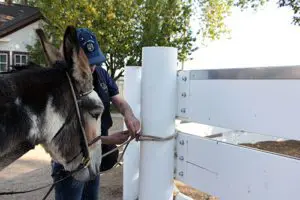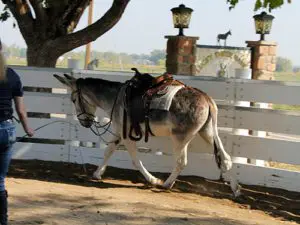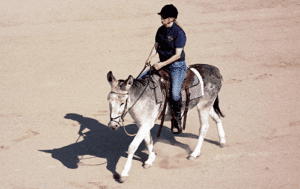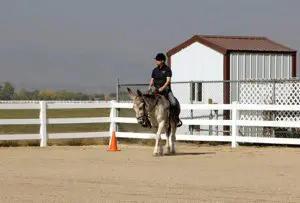WRANGLER’S DONKEY DIARY: Riding in the Open Arena: 10-6-20
A lot of people tell me they have problems when their jennets or molly mules are in heat. And, they expect the behaviors of their gelding to change drastically when they are castrated. In my experience, it really doesn’t make much difference if you have a fair and equitable management and training program. When their bodies are managed in a healthy way and they are consistently taught good manners, they will be willing and able to perform well regardless. I always approach training in a fair and equitable manner that does not throw too much at them all at once so as to avoid anxiety. Wrangler and Chasity both appreciate this (as did my jack, stallion and other females). It wasn’t until AFTER this lesson that I realized that Chasity was in heat and Wrangler was EXCITED about it! This program is a slow, logical and sequential approach that the equines truly appreciate and respond to positively no matter their mood. The results are miraculous!
Today, we were to begin with an interview about donkeys. Wrangler watched intently while Robbie wired me with the microphone. Then we went to the center of the Round Pen where I set him up and asked Wrangler to stand quietly while we did the interview, and he did what he was told. Such a good boy!
After the interview, Wrangler did his exercises of five rotations at walk, trot and even a little bit of canter. He is getting really good about stretching his spine from head to tail and his flexibility is greatly improved.
Since Wrangler had previously bolted with the lunge line in the dressage arena, I thought another lesson might be in order. I asked for the halt. Then we went to the open arena where I tied the end of the lunge line to the his bit with four inches to spare that I ran under his chin and snapped to the bit ring on the other side. This would prevent the bit from being pulled through his mouth.
I first lunged him to the right at walk and trot, halted him and changed the line to the other side. I gave a slight pull on the lunge line as his outside front leg was in suspension as a cue to keep him on the arc of the circle.
Wrangler did very well, so I stopped him and he stood quietly while I rolled up the lunge line. He followed me when I put away the line and stood still again while I prepared to mount.
Once mounted, the reward was in order followed by a rein back. He was offering more steps in each new lesson with only very slight squeeze/releases from my little fingers.
We did a very well-balanced turn on the haunches and made our way into the Hourglass Pattern. Wrangler proceeded forward with an energized working walk.
Wrangler remained erect in his body carriage as we made our way through the pattern, bending his body appropriately through his rib cage to the arcs of the turns and moving in good posture on straight lines.
Wrangler remained soft in his response to my hands, seat and legs. Donkeys are notorious for leaning against pressure, so it was imperative that I kept myself relaxed and “giving” to his movement.
Wrangler’s internal pendulum kept him moving through the Hourglass Pattern in a very nice balance, first through the pattern one way, across the diagonal and again in the opposite direction. My inside leg at the girth on the turns helped him to stay erect while my outside leg was well back to support the bend and encourage impulsion.
Wrangler obediently executed a square halt followed by a nice rein back with the lightest of cues from my fingertips. When you are patient and spend the time to train your equine this way, it makes a world of difference in their gaits and produces an incredibly smooth ride!
Wrangler stood quietly during the dismount and went through the gate perfectly! It was truly a resistance-free lesson! That is what you will get when you spend time on accuracy and wait for speed to come later.
Wrangler and Chasity both stood stock still while I got Chasity untied, then we all walked happily in sync together back to the Tack Barn! Leading them together is never a problem! The boundaries to good behavior have been established from the very beginning. They both know clearly what is expected!
































Margi Greene
February 20, 2021 @ 11:43 am
wonderful looking workout! So calm and thoughtful.
My question is about the use of the figure eight noseband. In the distant past I was told to used a figure eight on my horse (I was in 4-H at the time and am now 65) for various training exercises – didn’t use it all the time.
Am curious why you feel Wrangler needs it for his learning? I see that Chastity is wearing a regular cavesson, does she not need the same sort of support a figure eight offers or is she in a different place in her learning?
I have played with donkeys at Pat Block’s place and noticed how one of her jennets did not pay attention during her heat cycle. I did not work with her long enough to figure how to deal with keeping her focus on her ‘lesson’ than her heat cycle. Haven’t played with Pat’s donkeys in a long time – really enjoyed them.
Thanks!
Bailey Folker
February 24, 2021 @ 4:33 pm
Hi Margi, you can email Meredith at meredith@luckythreeranch.com and she would be happy to answer your questions in detail for you.
Meredith
March 8, 2021 @ 2:05 pm
I noticed you did not email me, so I will answer your questions here. I do not use a figure-eight nose band at all. I have found that is is too difficult to adjust the tension as needed in the two places where it surrounds the nose. I use flash nose bands that afford me the option of adjusting the two nose bands separately. I use the “flash nose band” to encourage them to stop opening their mouth or stop sticking their tongue over the bit as needed. Sometimes they are fine and won’t need it and sometimes they are not. I have used he flash nose band on both of them as I do on all of my equines…as needed. As for getting the attention of my females in heat…everything is done routinely, in a logical and predictable order. When my females are in heat, I just stay with the program and put less pressure on them to perform and everything goes just fine. I never have a problem with them not paying attention. When you “play” with them, they do not have a predictable routine to rely upon and can easily become distracted.